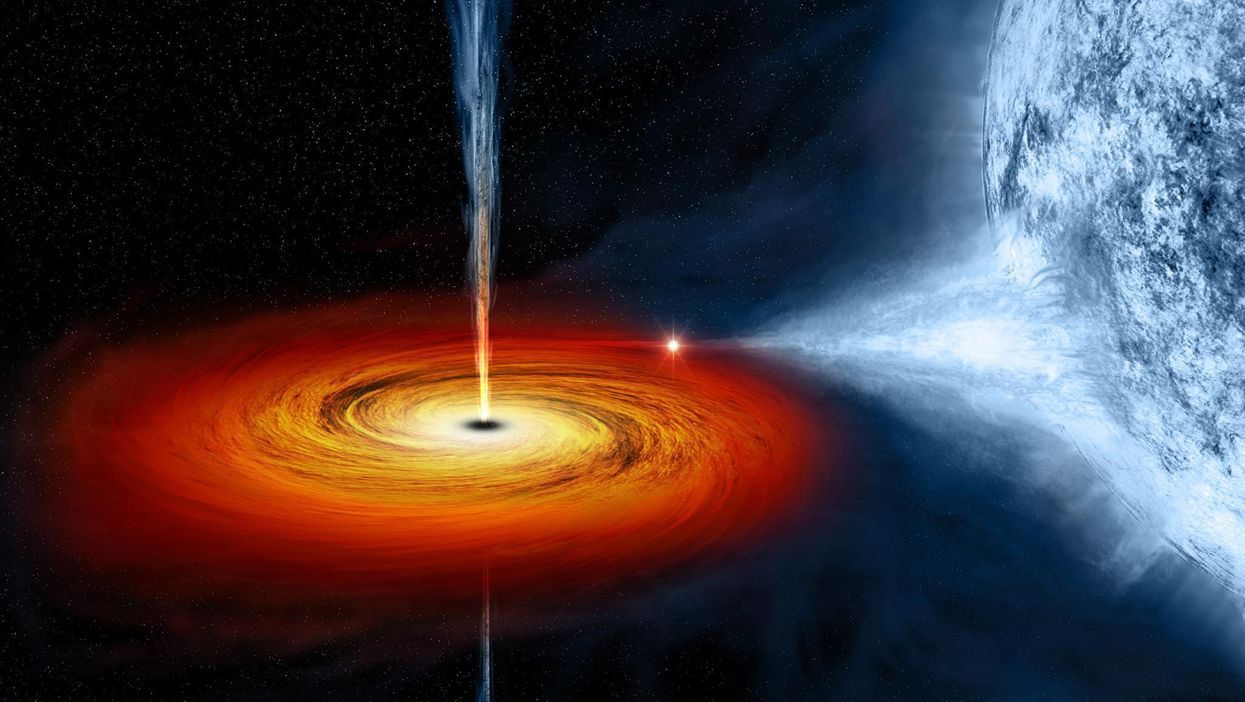News
Hossam Aly
Aug 09, 2017

A black hole swirling in space
Astrophysicist Hossam Aly addresses the common misconceptions people harbour about black holes in our galaxy for Quora.
I’m SO glad you asked this question! Finally I can write them down here once and for all.
These are the three most common misconceptions about Black Holes that I personally encounter:
Galaxies orbit their central Black Holes:
We’re all familiar with our solar system, where a bunch of planets and asteroids (and glorified rocks, such as Pluto) orbit a central object. Astronomers call that a Keplerian system (i.e, follows Kepler’s laws of motion). In these systems, the mass is completely dominated by the central object and each of the other objects can be treated as a test particle orbiting this massive object in the centre in an eccentric orbit according to Kepler’s laws with an average orbital velocity decreasing with the distance from the central object like R−1/2R−1/2.
Many people assume the same applies for galaxies, where stars and clouds of gas orbit the central Black Hole. This is not true. We’ve always known that galaxies aren’t Keplerian systems since stellar orbital velocities are observed to be mostly independent of radius. But now that we can measure some Black Hole masses, including our own Sagittarius A* that lives in the centre of the Milky Way, we can be more quantitative. We can define a sphere of influence for central Black Holes which is the roughly spherical volume in which the gravitational potential of the Black Hole dominates over that of the host galaxy. This can be estimated by:
R=GMHσ2R=GMHσ2
Where MHMH is the mass of the BH and σσ is the stellar velocity dispersion.
When we plug in the numbers for Sagittarius A*, we find that its sphere of influence has a radius of about 3 parsecs (1 parsec = 3.26 light years. Astronomers rarely ever use light years as a measure of distance, unless they’re speaking to the press). This is a TINY radius compared to the Galactic scale. It’s so tiny that only about 100 or so stars live there, compared to the estimated 200 billion stars in the Milky Way. Only those 100 stars can be said to orbit the Black Hole. Our solar system is located more than 8000 parsecs from the centre, and we’re only about two thirds of the way to the edge.
You can also get a feel of how gravitationally insignificant Sagittarius A* is by just comparing its estimated mass to that of the Milky Way. Sagittarius A* is about 3.6 million solar mass, while the total (stars + gas + Dark Matter) mass of the Milky Way is in the ballpark of 10121012 solar mass. That’s a factor of almost a million times more massive.
Black Holes suck in everything around them:
We’ve already established above that stars outside the sphere of influence don’t even orbit the Black Hole. But for the 100 or so stars that live within 3 parsecs of Sagittarius A*, should they worry about being potential snacks?
The thing about Black Hole gravity is that it’s just like gravity of any other object with mass. Gravity doesn’t cause objects to fall in (unless you have zero tangential velocity in the central object’s frame of reference), rather it causes things to orbit. That’s the same reason the earth has been orbiting the sun for 4.5 billion years without falling in. If the sun was a Black Hole with the same mass, our orbit would’ve been the same. This is simply because of what we call conservation of angular momentum, which is a simple consequence of Newton’s laws.
Disclaimer: there are non-Newtonian precessional effects for orbits around Black Holes that are due to General Relativity. These can only be felt very close to the Event Horizon. As I’ll explain below, for many Black Holes you’ll have bigger problems to worry about than orbital precession if you’re that close.
For those 100 stars living less than 3 parsecs aways from Sagittarius A*, they need only to worry from what we call the tidal effects of the Black Hole (commonly known as spaghettification). This effect is due to the fact that gravitational force drops as R−2R−2. For stars that get too close to the Black Hole, the side facing the Black Hole will feel a much stronger gravitational attraction than the other side. At some point this tidal field will be stronger than the star’s self gravity, and the star will be tidally disrupted. The Black Hole will then feed on the gas captured from the destroyed star. But at what distance will that occur? We can calculate the tidal radius of a Black Hole from:
Rtidal=(MHM∗)1/3R∗Rtidal=(MHM∗)1/3R∗
Where M∗M∗ and R∗R∗ are the mass and radius of the victimised star.
Plugging in the values for our sun and Sagittarius A*, we get a radius of 100 million km (less than 1 AU, the average distance of the earth’s orbit around the sun). This is really small compared to the 3 parsec sphere of influence. In fact out of the 100 stars in the sphere of influence, none of them is anywhere near that close. The nearest star to Sagittarius A* that we know of is SO-2 and on closest approach it gets to 120 AU from it.
I should probably stop here regarding this particular misconception, but it’s a perfect opportunity to present another neat result of Black Hole physics.
Let’s say that due to some dynamical effect during the evolution of the galaxy, many stellar orbits are thrown to distances within the Black Holes tidal radius and are falling prey to its appetite. How much can the Black Hole actually consume?
The material captured by the Black Hole from the destroyed stars still have some rotation WRT the Black Hole and, again due to conservation of angular momentum, will not fall in directly. They will form what we call an accretion disc in which friction will cause mass to be transferred inwards until it crosses the Event Horizon. In this process, the gas will convert its Kinetic Energy to heat, which will be radiated away. But radiation exerts pressure which, like gravity, falls as R−2R−2. This means that both effects will balance each other at some maximum accretion rate that only depends on the mass of the Black Hole. This is what we call the Eddington limit. (The limit is only an approximation since it assumes spherical symmetry and that the gas is only ionised Hydrogen.)
The maximum accretion rate M˙eddM˙edd is given by:
M˙edd=4πGMmpϵcσTM˙edd=4πGMmpϵcσT
Corresponding to a maximum Luminosity LeddLedd:
Ledd=4πGMmpcσTLedd=4πGMmpcσT
Again picking Sagittarius A*, the maximum accretion rate is about 0.010.01 solar mass per year, producing a luminosity of about 1011L⊙1011L⊙, or 100 billion solar luminosity (roughly the same luminosity of all stars in the Milky Way combined).
So you can see that Black Holes are in fact very reluctant eaters, though they tend to vomit vigorously.
Black Holes have very high density:
Well, the little ones do. But the massive ones that live at the centres of galaxies aren’t really that dense at all.
This is very straightforward:
Caveat:Black Holes don’t really have a radius in the usual sense and thus no well defined volume or density. But if you treat the Event Horizon as the extent of the Black Hole, you get the following:
The Schwarzschild radius (the Event Horizon for a non-rotating Black Hole) is given by Rs=2GMHc2Rs=2GMHc2. Notice that it’s linear in mass!
So the volume would go as V∝M3V∝M3.
But the density is ρ=MVρ=MV. So for a Black Hole it would go as ρρ∝M−2.∝M−2.
i.e, the density decreases as M−2M−2
Let’s look at some values:
A typical stellar mass Black Hole (of which it’s estimated that 100 million live in the Milky Way) with a mass of 10M⊙10M⊙ (10 times the mass of the sun) will have a density of ∼1016∼1016 kg/m^3, or 10 million million times the density of water.
Sagittarius A* has a density of ∼106∼106 kg/m^3, or a thousand times the density of water. (Note that Sagittarius A* is an atypically small Black Hole for a galaxy like the Milky Way)
A typical Supermassive Black Hole in a decent galaxy would be about 108M⊙108M⊙ (100 million times the mass of the sun). This will have a density of ∼100∼100 kg/m^3, or 10% the density of water.
One of the most massive Supermassive Black Hole observed is the one at the centre of the galaxy NGC1600 with a mass of 17 billion suns. It would have a density of ∼0.01∼0.01kg/m^3, or one part in 100,000 times the density of water, or 1% the density of earth atmosphere at sea level.
I wouldn’t call that very high density.
More: The first protest in space just happened, and it was against Donald Trump
Top 100
The Conversation (0)













